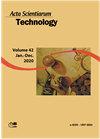沥青混合料在蠕变和超铺压实参数方面的力学行为研究
IF 0.6
4区 综合性期刊
Q3 MULTIDISCIPLINARY SCIENCES
引用次数: 2
摘要
这是一项关于热沥青混合料的力学行为的研究,考虑到静态蠕变试验和Superpave压实曲线的参数。在沥青混合料的生产中,使用了矿物集料和两种沥青粘结剂(CAP 50/70和AMP 60/85)。使用Superpave方法设计了这些混合物,并根据设计在内容和旋转次数上进行了压实。在设计条件下,使用常规CAP 50/70沥青粘结剂的沥青混合料比使用AMP 60/85聚合物粘结剂的沥青混合料具有更好的和易性和更低的变形。此外,考虑设计中的最大旋转次数,研究了沥青粘结剂含量对沥青混合料永久变形和压实指标的影响。在本研究中,沥青粘结剂含量越高,沥青混合料的永久变形越大,和易性越好。与之相辅相成的是压实曲线指数(Construction density Index, CDI;修正交通密度指数(TDIm)和锁定点(LP)与静力蠕变试验参数(恢复期后总变形Dt;蠕变模量,CM和曲线倾角,Icurve)通过这些指标之间的相关性得到的曲线。基于此分析,静态蠕变试验结果与压实指标之间存在良好的相关性,表明这些指标在预测所分析混合物的力学行为与永久变形的发展之间具有潜力。本文章由计算机程序翻译,如有差异,请以英文原文为准。
Study of the mechanical behavior of asphalt mixtures in terms of creep and Superpave compaction parameters
This was a study on the mechanical behavior of hot asphalt mixtures with regard to permanent deformation, considering static creep tests and the parameters derived from the Superpave compaction curve. For the asphalt mixture production, mineral aggregates and two types of asphalt binder (CAP 50/70 and AMP 60/85) were used. These mixtures were designed using the Superpave methodology and compacted in the content and number of gyrations according to the design. For the design condition, asphalt mixtures using the conventional CAP 50/70 asphalt binder showed better workability and lower deformation than asphalt mixtures with the AMP 60/85 polymer binder. Furthermore, the influence of asphalt binder content on the behavior of asphalt mixtures in relation to permanent deformation and compaction indices was studied, considering the maximum number of gyrations in the design. Regarding this investigation, asphalt mixtures with higher asphalt binder content tend to show higher permanent deformation and better workability. Complementarily, the compaction curve indices (Construction Densification Index, CDI; modified Traffic Densification Index, TDIm and Locking Point, LP) were correlated with parameters obtained from static creep tests (total deformation after the recovery period, Dt; creep modulus, CM and curve inclination, Icurve) through curves obtained by the correlation between these indices. Based on this analysis, a good correlation was found between the results of static creep tests and compaction indices, showing the potential of these indices for predicting the mechanical behavior of the analyzed mixtures in relation to the development of permanent deformations.
求助全文
通过发布文献求助,成功后即可免费获取论文全文。
去求助
来源期刊

Acta Scientiarum-technology
综合性期刊-综合性期刊
CiteScore
1.40
自引率
12.50%
发文量
60
审稿时长
6-12 weeks
期刊介绍:
The journal publishes original articles in all areas of Technology, including: Engineerings, Physics, Chemistry, Mathematics, Statistics, Geosciences and Computation Sciences.
To establish the public inscription of knowledge and its preservation; To publish results of research comprising ideas and new scientific suggestions; To publicize worldwide information and knowledge produced by the scientific community; To speech the process of scientific communication in Technology.
 求助内容:
求助内容: 应助结果提醒方式:
应助结果提醒方式:


